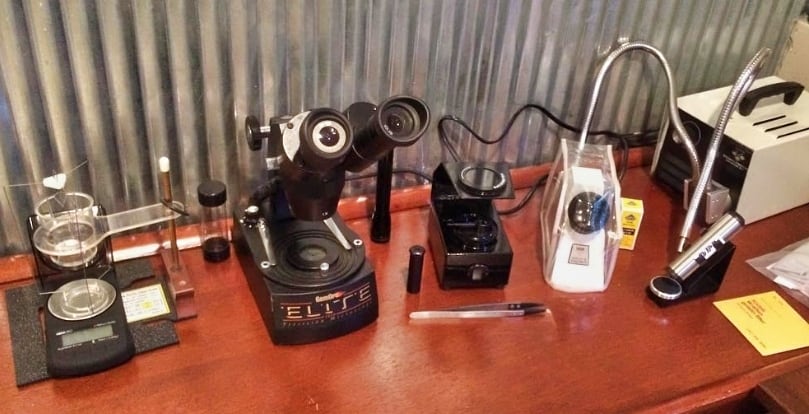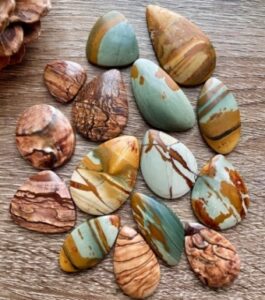Jasper’s an opaque, fine-grained Chalcedony species comprised of microscopic quartz crystals intermixed with several impurities. It comes in any color and takes on several appearances.
One thing you will see with jasper is the naming convention. Most varieties of jasper are named for the location they’re found or it describes exactly what type of jasper it is. For example, a bloodstone looks like a stone with drops of blood in it while picture jasper looks like someone painted a picture in the stone.
Some of the most popular and well-known varieties are red jasper, yellow jasper, black jasper, ocean jasper, green jasper, raw jasper, picture jasper, bloodstone, brecciated jasper, bumble bee jasper, and porcelain jasper.
How to Identify Jasper Through Testing
There are various ways to identify rocks, minerals, crystals, and gemstones, but we will be using a method I learned while attending the Gemological Institute of America. If you’ve learned a unique way to identify gems, then feel free to share it with us.
Let’s take a deeper look into how to identify jasper like a pro.

Visual Inspection
The visual inspection starts with what form of jasper you have. The questions below are relatively easy to answer, but each type will have its own process for identifying them. As you work your way through the visual inspection you might determine early on that you don’t have a piece of jasper. Instead, you might have a piece of agate which is commonly mistaken for jasper. Don’t worry, you’re in luck because I have a “how to identify agate” page that can help you.

Is it a cabochon? If you’re dealing with a cabochon, then it should have a medium to high polish with very little pitting on the surface. The colors in the stone should be modeled or patchy in nature. Earth tones are more common than bright colors.
Is it faceted? Very seldom is jasper faceted because it is opaque. It’s more likely to find beads and pendants made of jasper.
Is it a specimen? Jasper is found in different forms, and you’ll get better at identifying these forms by looking at and inspecting this mineral over time. Here’s a list of characteristics Jasper displays when it’s a specimen.
- Colors and patterns will vary, but in many specimens, the patterns are clear. However, some specimens, like Red Jasper, are sometimes found a solid red with a few changes in the shade.
- Expect red, blue, shades of brown, yellow, gray, and orange.
- Raw or rough Jasper is often found in palm-sized specimens and smaller.
- The most common specimens found are red and yellow, depending on location.

Is it tumbled? Very common to find tumbled jasper. Again, medium polish with very little pitting. Colors and patterns will vary.
Physical Properties of Jasper
Let’s take a look at the physical properties of jasper. Knowing what to look for will help you more easily identify what you’re looking at.
Color: Blue, Red, Green, Yellow, White, Orange, Brown, Gray, Black, Multicolored
Clarity / Transparency: Opaque
Luster: Vitreous
Cleavage: Indiscernible
Fracture: Uneven
The Streak Test
This is a destructive test, so you need to ensure that you’re allowed to damage the specimen or stone if you choose to use this method. Once you’ve developed robust knowledge in identifying rocks and minerals, you won’t be using destructive tests.
A mineral streak test involves scraping the stone against a harder surface to see what color remains. Jasper produces a white streak.
Tumbled specimens are tested by scraping a specimen across a piece of ungalvanized porcelain, typically known as a streak plate.
Magnet Test
Jasper is magnetic. The presence of iron is the main reason stones are magnetic. Different stones contain different minerals. It just so happens the iron ore present in Jasper causes it to be magnetic. That said, the magnetic attraction will vary depending on the color of the stone and how much iron is present. Yellows, reds, and oranges will typically show a weak to moderate magnetic attraction.
Hardness Test
I don’t recommend actively testing the hardness of a stone because it’s destructive in nature and doesn’t really provide a definite answer to what type of stone it is. With that being said, Jasper has a hardness of 6.5 – 7 on the Mohs hardness scale.
Refractive Index Test
Determining the refractive index, or RI as it’s referred to by gemologists, for Jasper is fairly straightforward, but you’ll need a specific piece of test equipment and the RI fluid to go with it. Before you place the stone on the refractometer, you want to make sure you have a flat, somewhat polished surface to take a reading.
Jasper’s Refractive Index: 1.54 – 1.55
Each gemstone has its own RI, so discovering a sample’s RI can help you figure out what sort of stone it actually is.
Step 1 – Place a small bead of RI fluid on the metal surface of the refractometer near the back of the crystal hemicylinder (the window on which the stone will sit).
Step 2 – Place the stone facet face down on the fluid dot and slide it toward the middle of the hemicylinder crystal using your fingers.
Step 3 – Look through the viewer lens without magnification. Continue looking until you see the outline of a bubble, then look at the bottom of this bubble. Take the reading from there, rounding the decimal to the nearest hundredth.
From time to time, you’ll run into the issue of not having a flat surface to work with. In this instance, you’ll need to leave the top of the refractometer open and hold the rounded stone with your hand. Hopefully, you’ll be able to pull a reading off of the gauge.
Birefringence Test
You won’t be using this test for Jasper, but I wanted to include this test just in case you were considering it in your process.
Consider testing the birefringence, as well. Birefringence is related to RI. While doing the birefringence test, you will turn the gemstone on the refractometer six times throughout the observation period and note the changes.
Perform a standard RI test. Instead of keeping the stone still, gradually turn it 180 degrees, making each separate turn about 30 degrees. At each 30-degree mark, take a new RI reading.
Subtract the lowest reading from the highest to find the stone’s birefringence. Round it to the nearest thousandth.
Birefringence: δ = Not Detectable
Single or Double Refraction
You won’t be using this test for Jasper, but I wanted to include this test just in case you were considering it in your process. For this test to be accurate and beneficial, the stone needs to be transparent in nature. If the light won’t pass through the stone, then there is no way to test for single or double refraction.
Check for single or double refraction. Use this test on translucent and transparent stones. You can determine whether the stone is only singly refractive (SR) or doubly refractive (DR) to help identify it. Some stones can also be classified as aggregate (AGG).
Turn on the light of a polariscope and place the stone face down on the lower glass lens (polarizer). Look through the top lens (analyzer), turning the top lens until the area around the stone looks darkest. This is your starting point.
Turn the analyzer 360 degrees and watch how the light around the stone changes.
If the stone appears dark and stays dark, it is likely an SR. If the stone starts light and stays light, it is likely AGG. If the lightness or darkness of the stone changes, it is likely DR.
Checking The Diaphaneity
Diaphaneity refers to the mineral’s ability to transmit light. For instance, some minerals are transparent or translucent. When they’re thick, a small amount of distortion might occur, but light will pass through them relatively freely.
Jasper is translucent. However, its translucency depends on the form it has taken. If the Jasper has an earthy form, there won’t be much light traveling through it. Still, if it happens to take on a crystalline structure, you should expect an opaque diaphaneity.
Finding The Specific Gravity
Every stone has its unique specific gravity, which helps us identify them. Specific gravity is one of the best properties to measure when identifying mineral specimens. Most minerals have a narrow range of specific gravity, so getting an accurate measurement can go a long way toward identification.
Specific gravity is a unitless number describing how heavy a mineral is compared to equal volumes of water. For example, if a mineral is three times as dense as water, it’ll have a specific gravity of three. This is useful because while two minerals might be the same size, they’ll each have a different specific gravity.
The larger the sample, the more precise the readings tend to be. Remember that this technique can only be used for single mineral or crystal masses. It will not work for minerals embedded in host rocks.
Jasper’s Specific Gravity: 2.7
As helpful as specific gravity is for identifying minerals, amateurs are usually constrained by the lack of necessary tools for the job. However, one way to work around this is to hold the specimen and note how heavy or heft it feels compared to what you might expect a specimen of that size to weigh.
If you want to determine the specific gravity of your stone like a pro, you’ll need to invest in a higher-end scale. This is the one gemologists use OHAUS Density Determination Kit.
Identifying Rocks and Minerals Like a Pro
Hopefully, you feel confident in your practice to identify a piece of jasper after reading and applying this guide. You’ll be using the visual part of this guide the most, and you’ll get better as you interact with more gemstones. Before you know it, you’ll be identifying stones like a gemologist.
If you run into any issues or get confused, then feel free to reach out, and I’ll do my best to assist you in the identification process.
- Identify Enstatite - March 12, 2024
- Identify Cerussite - March 3, 2024
- Identify Bytownite - February 18, 2024
